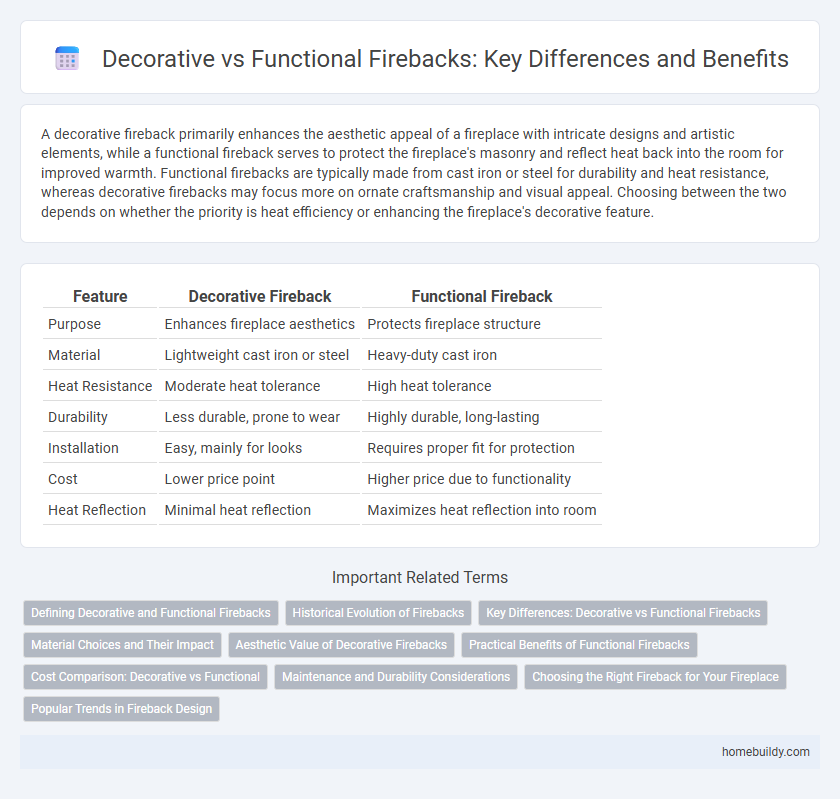A decorative fireback primarily enhances the aesthetic appeal of a fireplace with intricate designs and artistic elements, while a functional fireback serves to protect the fireplace's masonry and reflect heat back into the room for improved warmth. Functional firebacks are typically made from cast iron or steel for durability and heat resistance, whereas decorative firebacks may focus more on ornate craftsmanship and visual appeal. Choosing between the two depends on whether the priority is heat efficiency or enhancing the fireplace's decorative feature.
Table of Comparison
| Feature | Decorative Fireback | Functional Fireback |
|---|---|---|
| Purpose | Enhances fireplace aesthetics | Protects fireplace structure |
| Material | Lightweight cast iron or steel | Heavy-duty cast iron |
| Heat Resistance | Moderate heat tolerance | High heat tolerance |
| Durability | Less durable, prone to wear | Highly durable, long-lasting |
| Installation | Easy, mainly for looks | Requires proper fit for protection |
| Cost | Lower price point | Higher price due to functionality |
| Heat Reflection | Minimal heat reflection | Maximizes heat reflection into room |
Defining Decorative and Functional Firebacks
Decorative firebacks primarily serve as artistic installations, featuring intricate designs or motifs that enhance the fireplace's aesthetic appeal without impacting heat efficiency. Functional firebacks are constructed from durable materials like cast iron or steel, designed to protect the fireplace structure and reflect heat back into the room, improving warmth distribution. Both types vary in thickness and material composition to balance visual appeal and thermal performance.
Historical Evolution of Firebacks
Decorative firebacks emerged in the 16th century as ornate cast iron panels featuring intricate designs and heraldic motifs, reflecting the artistic tastes and social status of the period. Functional firebacks, originally developed in medieval Europe, prioritized heat retention and stove efficiency by protecting the masonry and radiating warmth back into the room. Over time, these two forms converged, blending aesthetic craftsmanship with practical heat distribution, marking the historical evolution of firebacks from purely utilitarian objects to dual-purpose architectural features.
Key Differences: Decorative vs Functional Firebacks
Decorative firebacks primarily serve aesthetic purposes, featuring intricate designs and artistic motifs to enhance the visual appeal of a fireplace. Functional firebacks are constructed from durable cast iron or steel, designed to protect the fireplace structure by reflecting heat back into the room, improving heating efficiency. Key differences include material thickness, heat resistance, and their role in either ornamental enhancement or fireplace protection and heat distribution.
Material Choices and Their Impact
Decorative firebacks are typically made from cast iron with intricate designs, enhancing fireplace aesthetics without prioritizing heat efficiency. Functional firebacks utilize thicker cast iron or steel to improve heat retention and radiate warmth into the room effectively. Material choices impact durability and thermal performance, with cast iron offering superior heat conductivity compared to steel in both decorative and functional applications.
Aesthetic Value of Decorative Firebacks
Decorative firebacks enhance the visual appeal of fireplaces with intricate designs, artful patterns, and historical motifs, making them a focal point in interior decor. Crafted from cast iron or steel, these firebacks combine aesthetic value with durable materials, enriching the ambiance without primarily focusing on heat reflection. Their ornamental qualities often elevate the character of traditional and modern living spaces, blending functionality with artistry.
Practical Benefits of Functional Firebacks
Functional firebacks provide essential heat retention by absorbing and radiating warmth back into the room, significantly enhancing fireplace efficiency. Constructed from durable cast iron or steel, they protect the fireplace's masonry from damage caused by intense heat and sparks. This practical design extends the lifespan of the fireplace while improving indoor comfort and reducing energy costs.
Cost Comparison: Decorative vs Functional
Decorative firebacks typically cost less due to simpler materials and designs, averaging between $100 and $300, whereas functional firebacks made of heavy cast iron or steel range from $300 to $800 or more due to durability requirements. Functional firebacks provide enhanced heat reflection and protection for fireplace masonry, justifying their higher price with long-term performance benefits. Choosing between decorative and functional firebacks depends on budget constraints and the need for efficient heat retention versus purely aesthetic appeal.
Maintenance and Durability Considerations
Decorative firebacks often require less rigorous maintenance than functional firebacks since they primarily serve aesthetic purposes and are not exposed to intense heat or direct flame. Functional firebacks must be crafted from durable, heat-resistant materials like cast iron or steel to withstand high temperatures and frequent use, necessitating regular inspections for cracks or warping to ensure longevity. Proper cleaning and occasional re-seasoning of functional firebacks enhance durability and maintain heat efficiency, whereas decorative options mainly benefit from dusting and rust prevention treatments.
Choosing the Right Fireback for Your Fireplace
Decorative firebacks enhance the visual appeal of your fireplace with intricate designs and artistic motifs, while functional firebacks primarily protect the fireplace wall from heat damage and improve heat distribution. When choosing the right fireback, consider the material, such as cast iron for durability and heat retention, and the size to ensure proper fit and efficiency. Balancing aesthetics and functionality ensures optimal performance and complements your fireplace's style.
Popular Trends in Fireback Design
Decorative firebacks feature intricate cast iron patterns, often showcasing historical motifs or nature-inspired designs, which enhance fireplace aesthetics and serve as focal points in interior decor. Functional firebacks prioritize heat retention and distribution, utilizing thicker cast iron or steel materials to improve energy efficiency while maintaining a straightforward appearance. Popular trends blend both elements, with modern firebacks incorporating artistic designs that optimize heat reflection, appealing to homeowners seeking both style and performance in their fireplaces.
Decorative Fireback vs Functional Fireback Infographic

 homebuildy.com
homebuildy.com